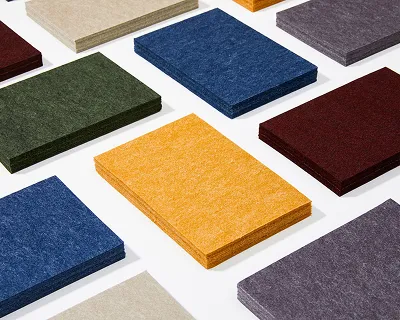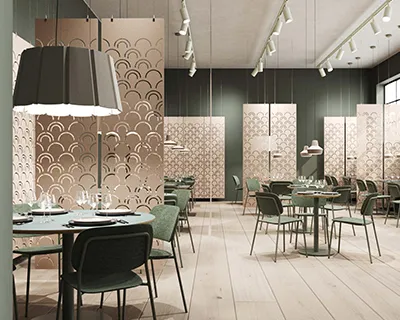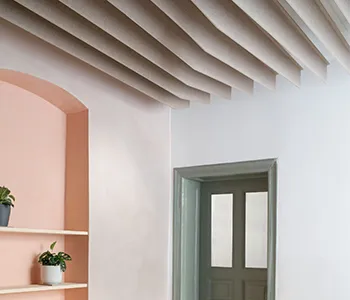Evite que su consulta sea de respuesta tardía, por favor introduzca su WhatsApp/Skype junto con el mensaje, para que podamos ponernos en contacto con usted a la primera.
Le responderemos en un plazo de 24 horas. Si para el caso urgente, por favor agregue WhatsApp/WeChat: +86-13678899682 directamente.
Noisy rooms push people away. Echoes make meetings hard and designs look unfinished. PET felt gives you clean acústico control with a gentle, modern texture—without blowing the budget.
PET in felt stands for polyethylene terephthalate. PET felt is a non-woven felt material made from recycled plastic fibers, shaped into panels and ceiling baffles para acústico control. It’s durable, lightweight, and an eco-friendly acoustic solution that helps reducir el ruido and improve speech clarity in busy spaces.

When people ask “what does PET stand for in felt,” they’re really asking what material powers the performance. PET stands for polyethylene terephthalate, a family of polyester plastics you already know from bottles and fibers. In an acústico context, fibers are bonded to form pet felt sheets and shapes that calm spaces and look refined.
As a professional manufacturer in China specializing in high-quality PET and wood acústico panels, we use pet felt in panels, baffles, and decorative elements for offices, schools, hotels, and public buildings. That means you get factory-level customization, short lead times, and a consistent surface quality on pet felt parts.
Explore available patterns and forms here: Paneles acústicos de fieltro PET (category guide, specs, and finish options).
PET felt is made by turning recycled plastic bottles into pet flakes, then into fibers. These fibers (you’ll also see the British “fibre”) are layered and heat-pressed, forming a dense, porous mat. The result is pet felt: a dimensionally stable sheet material with clean edges you can CNC or cut PET with a utility knife.
Unlike traditional felt (often wool), pet felt is a durable synthetic made for architecture: color-fast, low-shed, and consistent across batches. This innovative material keeps its shape, tolerates humidity swings, and resists pilling—ideal in lobbies, meeting rooms, or transit hubs where traffic and niveles de ruido are high.
If you need a base substrate overview, see the panel acústico de poliéster page that explains common densities and build-ups used with pet felt skins.
Here’s the short list—the benefits of PET felt for designers and contractors:
In technical terms, pet felt offers steady absorción acústica across speech frequencies. The fibers and air pockets scatter ondas sonoras and damp reflections, lifting confort acústico without heavy construction. As panels, clouds, or deflector arrays, pet felt supports human-friendly acoustics in open offices, schools, and retail.
Curated finishes for branding and wayfinding: perforated PET decorative panel (patterns and light effects that still perform).
You’ll find pet acoustic elements on open ceilings, corridors, conference rooms, and cafés. Above desks, ceiling baffles tame hard-surface reflections and keep plan layouts flexible. On benches and booths, thin pet felt layers help patrons hear each other.
For vertical rhythm and airflow, designers love slatted layouts. See an option that installs fast and reads as architecture: acoustic slat panel in PET. Need visual separation and acoustics together? Try hollow PET hanging dividers to soften zones without building walls.

Two ideas: micro-scale friction and path length. The porous matrix in pet felt converts motion into heat (tiny amounts) as air moves through fibers. That’s what makes excellent sound absorption properties possible. By adding distance and scatter, panels and baffles increase the path length for reflections—killing flutter and cutting reverberación.
Paired with placement at first-reflection points, pet felt achieves excellent acoustic performance for speech and music. Even small quantities, smartly placed, create a big step-up in rendimiento acústico and intelligibility.
Sí. pet felt behaves like a semi-rigid board: it cuts clean, keeps shape, and resists dents better than many open-cell foams. It is a durable fabric in daily use—vacuum or wipe to keep dust off. Maintenance is simple and easy to clean protocols fit most facility teams.
As a sheet material, pet felt stays flat when mounted with adhesive or clips. Edge details route cleanly, and fasteners hold without tearing. That stability is why pet felt panels and deflector sets survive in classrooms and transit while continuing to look sharp.
pet felt is often made from recycled plastic bottles collected, washed, and pelletized. Many lines are made from recycled PET content; some are even made from recycled feedstock at very high percentages. That helps remove plastic waste from the stream and turns it into long-life sustainable products.
Remember, PET is a new material to many owners, yet it’s simply made from PET—the same safe, ubiquitous plastic used in packaging. With careful sourcing, you can specify environmentally friendly content and stay environmentally mindful. For a wood-forward surface on a felt core, see PET acoustic panels with wood veneer finish.
Think in layers. Use acoustic baffles overhead for big-room control, then add feature walls that double as signage. Combine patterns (perforations, ribs) for style and flow. In team zones, pet felt backed by mineral fiber boosts low-mid control; in lounges, thin pet felt patterns warm the vibe without weight.
Lighting helps. Perforations act like stencils, creating soft glow through panels. For playful partitions that also work as acoustic productsEstos perforated PET decorative panel options are versatile. Where movement matters, hollow PET hanging dividers add motion and texture.

Most kits arrive pre-cut and easy to install. For an acoustic wall, map stud lines, mount rails or adhesive, press panels, then roll seams. For paneles de pared, align from center, keep a laser on reveals, and use jigs for outlets. Always follow fire and egress codes and confirm adhesive compatibility.
pet felt edges can be field-trimmed; yes, you can cut PET safely with sharp blades. For slat assemblies, fix the backer first, then clip slats. If you’re mixing surfaces (like felt + veneer), check tolerance on returns. In ceiling grids, confirm weight and hanger count per manufacturer.
Not all felt is equal. premium PET felt tracks to fiber length, density, binder quality, and color fastness. The best PET for open offices often runs 9–12 mm thickness with NRCs that hit spec without over-deadening. Hospitality may favor patterned 6–9 mm with brighter colors.
Typical PET Felt Spec Ranges
| Attribute | Common Values | Why it matters |
|---|---|---|
| Espesor | 6–24 mm | Thicker = higher absorption and stiffness |
| Densidad | 1.8–3.2 lb/ft³ | Tuning stiffness vs. absorption |
| NRC (panel) | 0.35–0.90 | Overall acústico effectiveness |
| Fire | Class A/B (ASTM E84) | Code acceptance for interiors |
For a substrate and panel family overview, compare options on panel acústico de poliéster. If you need category context or multi-format kits, browse Paneles acústicos de fieltro PET.
uses of PET felt span retail (logo walls), education (quiet reading nooks), and transit (wayfinding). Branded perforations, color-blocked pet felt ribs, and skylight ceiling baffles turn acoustic fixes into identity. For slatted layouts that ship flat, see acoustic slat panel in PET.
As an OEM/ODM factory, we integrate pet felt products into millwork kits, kiosk wraps, and venue signage. We also build hybrid sets—felt + veneer—when owners want both warmth and performance (see PET acoustic panels with wood veneer finish). For patterned features that still absorb, grab a look at perforated PET decorative panel.
| Característica | Fieltro PET | Traditional felt |
|---|---|---|
| Base | pet plastic fibers (made from polyester) | Wool or synthetic blends |
| Source | Often made from recycled PET / recycled PET bottles | Varies; less recycled content |
| Form | Panels, clouds, deflector kits | Mostly craft or upholstery |
| Look | Crisp edges; color stable | Softer edge; may fuzz |
| Care | Vacuum, wipe | More delicate |
| Utilice | Architecture, tratamiento acústico | Crafts, apparel |
Takeaway: For interiors, PET felt is the ideal choice when you need consistent color, clean edges, and control de sonido that owners can maintain.
A 400-seat lecture hall struggled with unwanted noise and smeared speech. We modeled first reflections and placed ceiling baffles and ribbed pet felt features along side walls. Results: clearer speech and more relaxed listeners. The facilities team loved the quick maintenance and easy to clean routine; the architect loved the soft shadows.
What exactly is PET?
PET is a plastic used in bottles and fibers; in felt form it stands for polyethylene terephthalate. In panels, it’s safe, stable, and built for interiors.
Are PET felts an eco-friendly option?
Yes. Many lines are made from recycled streams or made from recycled plastic bottles. It’s an eco-friendly path that turns plastic waste into long-life finishes.
How do I choose thickness?
Start with 9–12 mm for general speech; add clouds or deflector arrays where ceilings boom. For focused areas, thin skins over cores can be an excellent choice.
Can PET felt handle busy lobbies?
Yes. As a durable architectural material, pet felt resists wear, stays flat, and cleans fast. It’s a perfect solution for high-traffic areas.
Will PET change my acoustics of your space dramatically?
Placed at early reflection points, pet felt puede reducir el ruido and lift clarity. It’s ideal for acoustic improvements without heavy construction.
What’s different about pet felt panels and pet acoustic panels?
paneles de fieltro para mascotas are flat or formed sheets, while paneles acústicos para mascotas are tested systems with specified NRC. Both use pet felt cores and finishes.
¿Qué significa PET en el fieltro? Paneles acústicos de fieltro PET y control del sonido ecológico